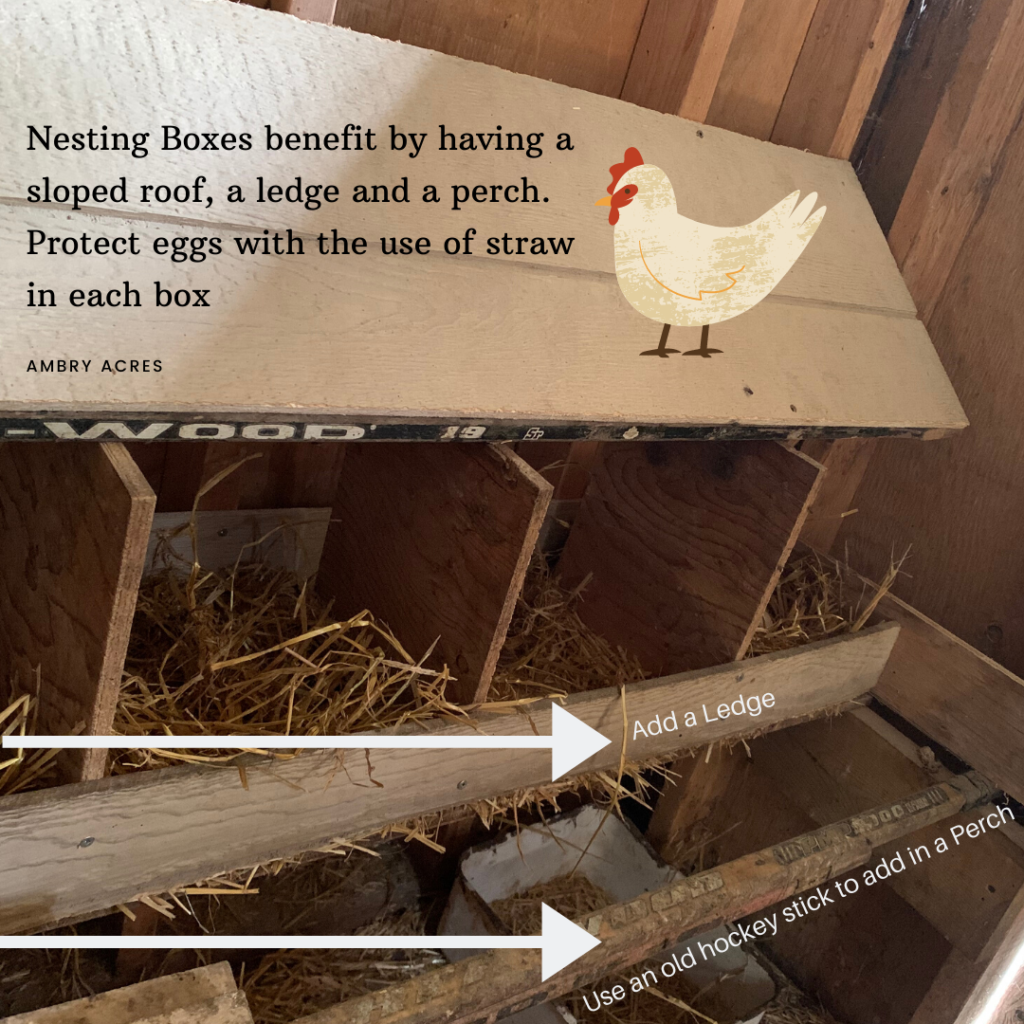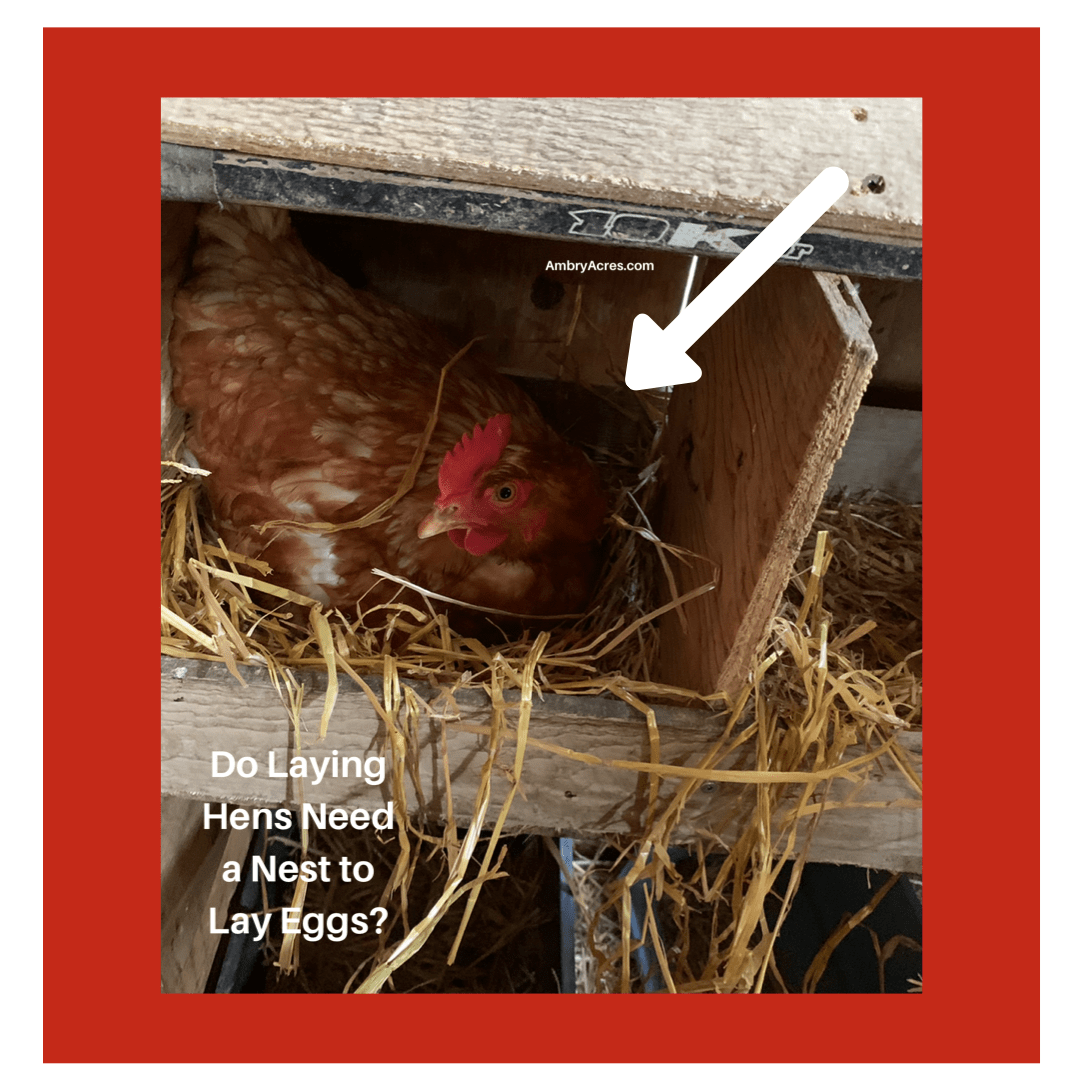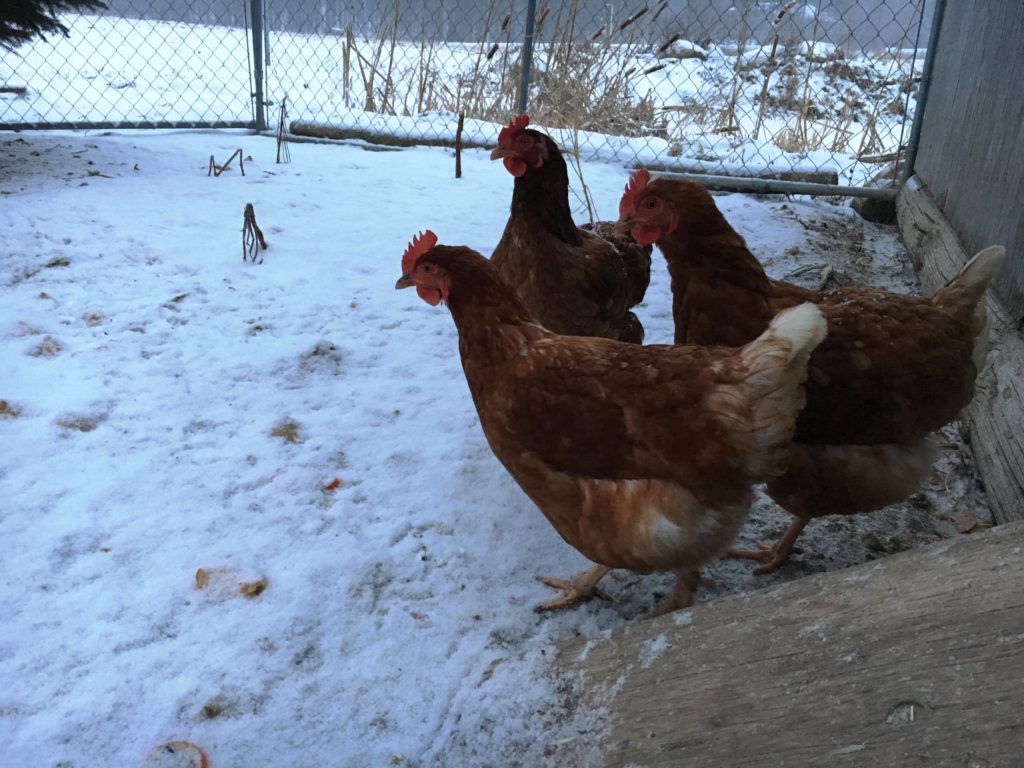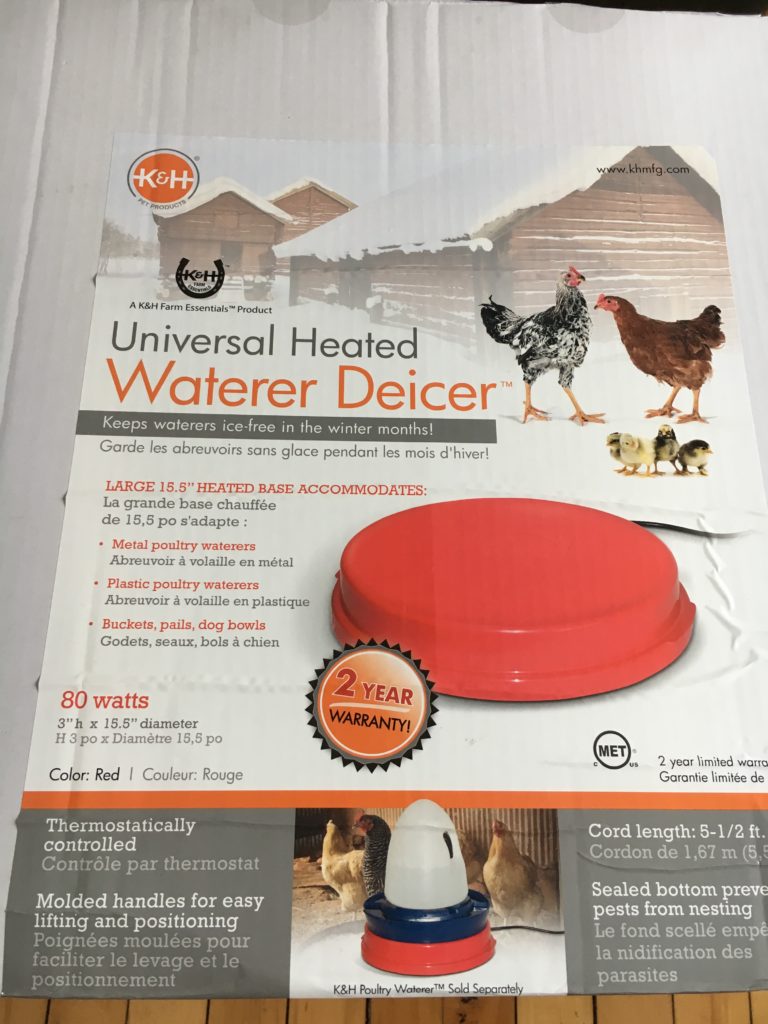Laying hens need a nest to lay eggs for easy collection.
When eggs are laid in nests designed to facilitate egg collection, they are also more likely to remain clean and undamaged.
Source: https://www.ncbi.nlm.nih.gov/pmc/articles/PMC5850654/
Create several comfortable, clean and cozy chicken nesting boxes. On our farm, we built the laying hens nest boxes into the coop along one wall allowing for easy access for egg collection.
A general rule for nesting box size is one 1-foot square nesting box for every four laying hens. The flock will take turns using the boxes. Line each nest box with a thick layer of straw or shavings to cushion the eggs. Keep the nesting boxes up off the floor in the darkest corner of the coop with privacy to the hen.
Each nest area should have a uniform environment. After a hen lays her first egg, it’s her tendency to lay in the same spot moving forward. If the hens decide one nest is preferable to the others, they may all try to use that nesting box, causing them stress, which can lead to egg breakage.
What happens if hens want to use the same nesting box?
Sometimes laying hens all use the same nest box even though they are all uniform. As long as the birds aren’t fighting or harming each other, this is probably not a big issue. If you are concerned about it, consider blocking access to the preferred nest box and guiding the hens to use one of the other available boxes. Once the hens have decided the other nest boxes work just as well, allow them access to the original nest box.
Source https://www.purinamills.com/chicken-feed/education/detail/when-do-chickens-start-laying-eggs
I was fortunate to be inside the coop to witness this behaviour. I decided to capture it on video to help explain the importance of having enough nesting boxes for the amount of hens. Additionally, to identify that hens will fight over using the same box.
Watch the video here to see the behaviour of laying hens fighting over using a nest box when laying eggs!
Do Chickens Need Nesting Boxes to Lay Eggs?
Chickens will lay eggs whether there are nesting boxes or not.
If there are no nesting boxes provided, hens will play around in the straw and lay wherever. Disadvantages are that time is required to find the eggs and sometimes they will get cracked due to hens walking around inside the coop prior to collection.
To create a happy space for raising happy hens, build nesting boxes with easy access for egg removal.
Nesting boxes help hens to feel safe and this provides a good sense of security for them.
Keep the nests up off the floor in the darkest corner of the coop.
Source: https://www.purinamills.com/chicken-feed/education/detail/chicken-coop-design-options
Nesting boxes should always be below the level of your roosts and properly secured to keep your flock safe.
Place straw or wood shavings in the bottom of the box and you have a comfortable nesting box for your chickens.
How many boxes do I need?
A general rule is to provide one 1-foot square nest box for every four or five hens because the flock will take turns using the boxes.
How big do nesting boxes need to be?
A general rule is to provide one 1-foot square nest box .Keep in mind that the nest boxes don’t have to go in until the birds are around 16 or 17 weeks.
Does the nest box have to have a top?
Nest boxes are normally, well, boxes. They don’t need to have a top on but it does help to keep the hens feeling comfortable, safe and secure, if they are enclosed.
You can see they use these nesting boxes quite happily.

Here is a picture of a block of nesting boxes with a sloped top to stop perching.
The reason that we suggestion building a sloped top is to prevent the hens from roosting up there which in turn prevents manure dropping into the nesting boxes.
Additionally, the sloped top creates a darker space which is ideal for laying.
Do chickens need separate nest boxes?
It is always best to plan to give them sturdy comfortable and separate places to lay their eggs.
I have noticed that my hens like to nest in the same nest box. We have 1 box for every 2 hens however they tend to lay in certain boxes and they take turns using the same box.
Do nesting boxes need walls or dividers?
We have had various types of nesting boxes and have improved our coop to have one nest box with dividers.

Nesting boxes are best with dividers.
A communal nest doesn’t work, because they break the eggs.
Should nest boxes be secured so they cannot move around?
Nest boxes need to be secure. Chickens move around the nest until they are comfortable and can tip up unsecured boxes trapping birds, causing injuries or breaking eggs. It does not take much, just a few screws into the wall is all that is needed.
If it’s only 1 hen per box they will move much less, being that they don’t have to shove around and push for a position. And a general rule with nesting is 1 box per every 4 to 5 hens you have. They will even take turns sitting sometimes.
What should nesting boxes be made from?
Although wooden nesting boxes are common, plastic and metal containers are less susceptible to bacteria and easier to sterilize. Chickens aren’t picky about what the nest box is made off but they are selective about where they lay eggs.
So you can use household or salvaged materials to design a snug, semi-enclosed nesting space quickly and for almost no money and keep your chickens happy at the same time.
I have used recycled plastic fridge drawers placed in a row or recycled large plastic containers that are square or rectangular because they sit flat. Hens will decide for themselves which spot they prefer and they will re-use over and over. Our hens choose the plastic fridge drawers most days. To keep things neat, we built a wooden structure that includes dividers to create separate boxes, added a ledge to develop a step and enclosure along with a sloped roof. These steps have created a cozy, dark and private space for the hens to sit and lay their eggs.
How much do nest boxes cost?
We had wood pieces kept from previous jobs already on-hand. Otherwise, recycled plastic containers can be collected from asking friends and family. We have made all of our nesting boxes with recycled products allowing us to creatively think of what we already have available to us because it doesn’t have to cost anything.
How high off the floor should the boxes be?
Nest boxes can sit on the ground or be elevated.
But keep in mind that nest boxes on the ground take away from use able floor space. I like to elevate them at least 18 inches so that my floor space is open.
If you’re stacking, you can always use chicken ladders or perches for the higher boxes.
I find that our hens tend not to use the nesting boxes that are arranged at ground level. There are never eggs to collect from these boxes as they tend to prefer to lay eggs in the boxes that are attached to the wall approximately 1.5’ from the ground.
Can I allow my young growers (pullets) access to the nest boxes?
You should make the effort to keep young birds (pullets) out of the nesting boxes until they learn to roost.
The first egg often arrives when hens are 18 weeks old, subject to breed, environment and nutrition.
We find it easier to have a separate section for those pullets and only introduce them to the main coop area and laying hens at 16 weeks of age.
What can I make nest boxes out of?
Wood is the material of choice because it is easy to work with and is long lasting. It has the advantage over plastic that it is heavier and is sturdy.
Metal is cold and can rust yet is a good choice. Easily bolted together to form blocks of nesting boxes for a flock.
They need to be sturdy. You can use old plastic trays, litter boxes, and fridge drawers to make nesting boxes, depending on the sizes of your chickens and the size of what you plan to use.
What do I fill chicken nest boxes with?
Fill the boxes with your preferred bedding to make a comfortable nesting space for your chickens.
Shavings offer better moisture resistance compared to straw.
However, due to the shortages on shavings during the COVID -19 Pandemic; we began using straw. Because we produce straw on our farm and have it readily available, we decided to continue.
Do nesting boxes need to be inside the coop?
Yes, they need to be your coop. Remember, the ideal setting is a dark, safe and private enclosed space.
Do chickens sleep in their nesting boxes?
We find that our hens sleep on their roosts. Roosts are items e.g.; recycled hockey sticks which are installed inside the coop to allow the hens to stand on. Roosts are anywhere from 2′ to 4′ above ground and they run from one side of the coop to the other. Collect eggs daily to ensure they are fresh and safe to eat.
Tips for looking after laying hens nest boxes:
- Make sure they are easy to clean.
- Chicken nesting boxes need a ledge on the front to keep the nesting material and egg inside.
- They need to be accessible.
- Collect the eggs daily to prevent broody hens or broken eggs consequently, ensuring you are eating fresh eggs.
Source: https://cluckin.net/chicken-nesting-boxes-everything-you-need-to-know.html

Source:
https://www.farmfoodcareon.org/wp-content/uploads/2017/05/Hen-and-Egg-fact-sheet-2016final.pdf






My hens all tend to use the same nesting box. They get mad at each other when one is in it and another wants to use it. Silly chicks!
Thanks Carrie for sharing your experiences with raising hens. Yes, our hens also tend to get aggressive with one another over whose turn it is to lay. Our hens have access to multiple nesting boxes yet they fight over using just two of them leaving the other boxes sitting empty.
Hello. I used to have chickens. Mine were bantams, Silkies to be precise, and they would never roost. They slept in the nest box. I used to say they ‘sleep in a heap’. Silkies are great brooders and would sometimes hide their treasures and I would have surprise chicks. I kept my chickens for fun. The eggs were a bonus. Happy chicken farming!
Hi Kimberly, thanks for sharing your experiences with chickens. Sometimes their behaviours are quite comical.
Very insightful and helpful! I have chickens and everything you listed is good sound advice, nicely put together too. This will definitely help out those new beginners 😊 Thanks for sharing Anne 👍🏼
Thanks Denise for your comments, much appreciated